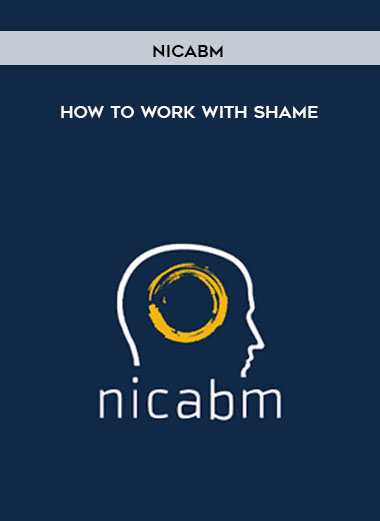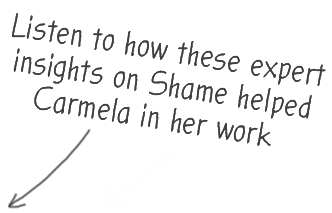NICABM – How to work with shame
$197.00 Original price was: $197.00.$45.00Current price is: $45.00.
Proof of item:
Successful Ways to Work With Clients Who Struggle With Deep Feelings of Shame
When a client experiences shame, they live in constant fear of being rejected. And they become trapped in the avoidance strategies they create to escape the pain.
However, shame left untreated grows more powerful. And it can often lead our clients into behaviors that invite even greater shame.
But to effectively work with shame, we have to understand its neurobiology and why it’s so difficult to erase its deep tracing on the nervous system. We need to know why shame vigilantly protects itself, and how our traditional treatments may be sustaining shame or driving it even deeper.
That’s why we’ve brought together 19 of the top experts in our field to bring you . . .
How to Work With Shame

How to Break the Power of Shame by Engaging it
Marsha Linehan, PhD Kelly McGonigal, PhD Ron Siegel, PsyD
Joan Borysenko, PhD Bill O’Hanlon, LMFT
- The one counterintuitive technique that removes the fear of rejection from shame
- The most common type of shame (and why clients often believe they caused it)
- How to approach treatment when a client’s shame is legitimate

The Way a Shame Posture Impacts Emotions (And How to Bring Clients Out of It)
Peter Levine, PhD Bill O’Hanlon, LMFT
Ron Siegel, PsyD Kelly McGonigal, PhD
- Why a posture of shame looks identical to a posture of trauma
- How to adjust your office seating to avoid triggering your client’s shame
- A guided exercise to help bring clients out of a posture of shame

How to Work With Shame When it’s Connected to Trauma
Part 1: A Way to Heal Trauma-Based Shame Using a 3-Dimensional Space
Bessel van der Kolk, PhD Bill O’Hanlon, LMFT
- The “meaning-making” system that allows shame to take over a client’s life
- Why differentiation is so crucial in eliminating shame
Part 2: Rewiring the Body’s Reaction to Shame and Trauma
Pat Ogden, PhD Kelly McGonigal, PhD
- How attachment shame can lead to broken adult relationships
- How to pull a client out of hypoarousal when shame causes them to dissociate
- How to shift the way a client physically organizes their history of shame

How to Shift Clients Out of Feelings of Unworthiness
Rick Hanson, PhD Ron Siegel, PsyD Kelly McGonigal, PhD
Joan Borysenko, PhD Bill O’Hanlon, LMFT
- Why it’s crucial to approach shame differently for introverts and extroverts
- How to use neuroplasticity to erase the old learning that promotes shame
- Why clients need to tolerate feelings of shame before undoing them

How to Work With the Inner Voice of Shame
Richard Schwartz, PhD Joan Borysenko, PhD
- The 2-part phenomenon that creates shame
- The inner personality that you must approach first (so it doesn’t sabotage your work)
- The one thing you need to do to get the inner critic to voluntarily disarm

The 4-Part Skill That Can Build Trust With Your Client
Dan Siegel, MD Kelly McGonigal, PhD Ron Siegel, PsyD
- What happens when the hippocampus fails to integrate implicit memories
- The difficult choice point a neglected child faces that invites lifelong shame
- How to help clients release deep feelings of inner defectiveness

How to Work With Shame That Developed in Childhood
Part 1 : The Generational Effects of Shame on Loved Ones
Sue Johnson, EdD Ron Siegel, PsyD Kelly McGonigal, PhD
Joan Borysenko, PhD Bill O’Hanlon, LMFT
- The one element of shame that creates havoc in relationships
- How shame is passed on to future generations
- The parenting style that generates an inner incompetence in children
Part 2: How to Work with Shame without Retriggering It
Zindel Segal, PhD Elisha Goldstein, PhD Joan Borysenko, PhD
- Why some clients may be unaware that shame is fueling their behavior
- The first thing you should identify when treating a client’s shame
- Why it can be risky to reveal the developmental connection to your client’s shame

The Impact of Shame Messaging and How to Dismantle It
Kelly McGonigal, PhD Terry Real, MSW, LICSW
Joan Borysenko, PhD Bill O’Hanlon, LMFT
- How unrealistic standards can lay the foundation for systemic shame
- The 3-second indulgence that helps unravel inner harshness

The Neurobiology of Shame
Part 1: How Shame Triggers the Body’s Shut-Down Response
Stephen Porges, PhD
- How to avoid triggering your client’s physiological response to shame
- The one intervention that can stop the body from shutting down
- How the body’s reflexive response to shame can lead to dissociation
Part 2: How the Psychobiology of Shame Can Help Your Work
Stan Tatkin, PsyD, MFT Ron Siegel, PsyD Bill O’Hanlon, LMFT
- How the nervous system traps your client in shame
- The one thing a loved one can do to regulate their partner’s shame
- What can go wrong when the practitioner’s shame gets triggered in a session

How to Unravel the Shame in Relationships
Part 1: The Crucial Role of an Attachment Figure in Treating Shame
Sue Johnson, EdD
- The big risk a client must take to gain a corrective experience
- The one assumption about love and caring that we almost always get wrong
Part 2: How Shame in a Relationship Can Trigger PTSD
Stan Tatkin, PsyD, MFT Bill O’Hanlon, LMFT Kelly McGonigal, PhD
- How to deal with a couple when one partner feels ashamed and the other feels betrayed
- The important thing a client needs to see when coming out of a shut-down state
- The one type of shame that can lead to a partner developing PTSD
Register Here for $197
and get 14 videos, audios, and transcripts, including 2 bonuses
to help you work more effectively with a client’s shame
4 CE/CME Credits or Clock Hours are available for purchase at checkout.
Click HERE to get information about CE/CME credits and clock hours as well as speaker disclosures
“The complexity of the dynamics are addressed better in the courses you teach than I’ve seen anywhere else.”
— Carmela Wegner, MFT —
Q & A
Ask a question
Your question will be answered by a store representative or other customers.
Thank you for the question!
Your question has been received and will be answered soon. Please do not submit the same question again.
Error
An error occurred when saving your question. Please report it to the website administrator. Additional information:
Add an answer
Thank you for the answer!
Your answer has been received and will be published soon. Please do not submit the same answer again.
Error
An error occurred when saving your answer. Please report it to the website administrator. Additional information:
Related products
Uncategorized
Uncategorized
Uncategorized
Uncategorized
Uncategorized
Uncategorized
















Thank you very much | NICABM – How to work with shame